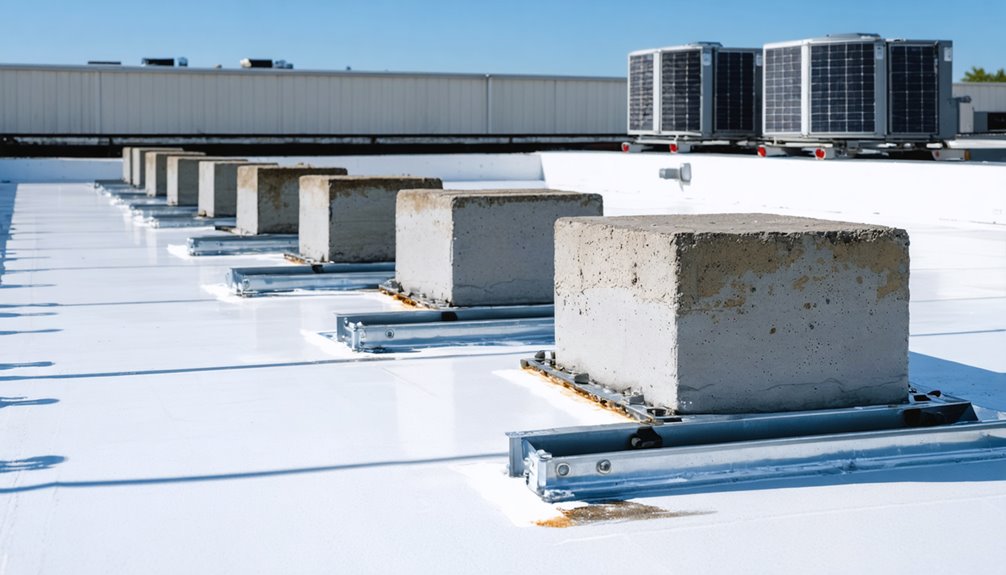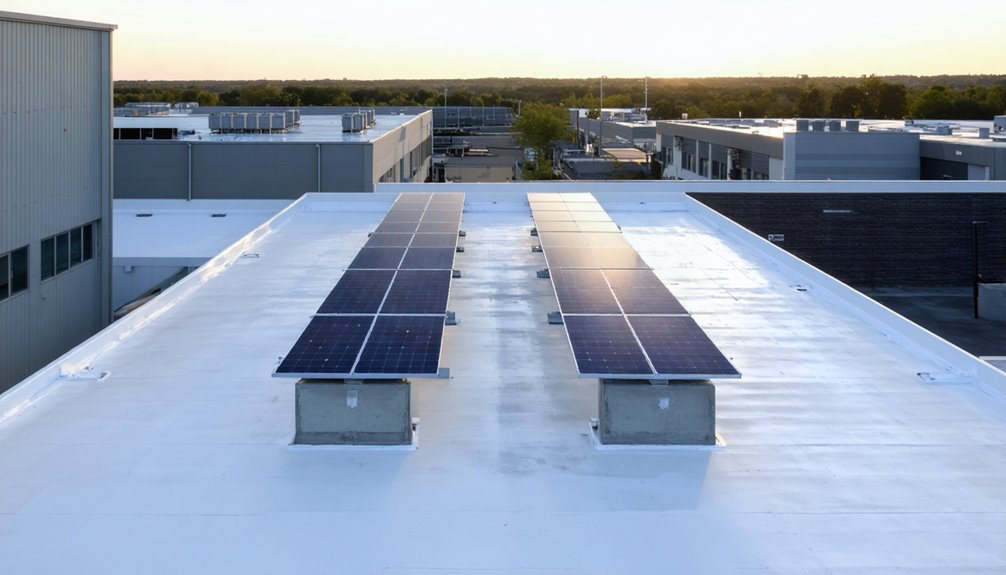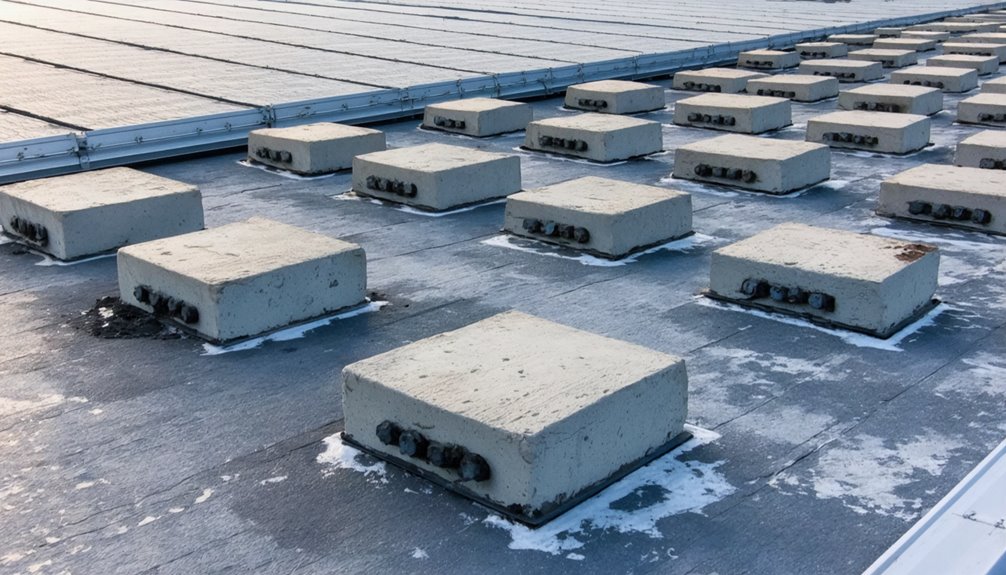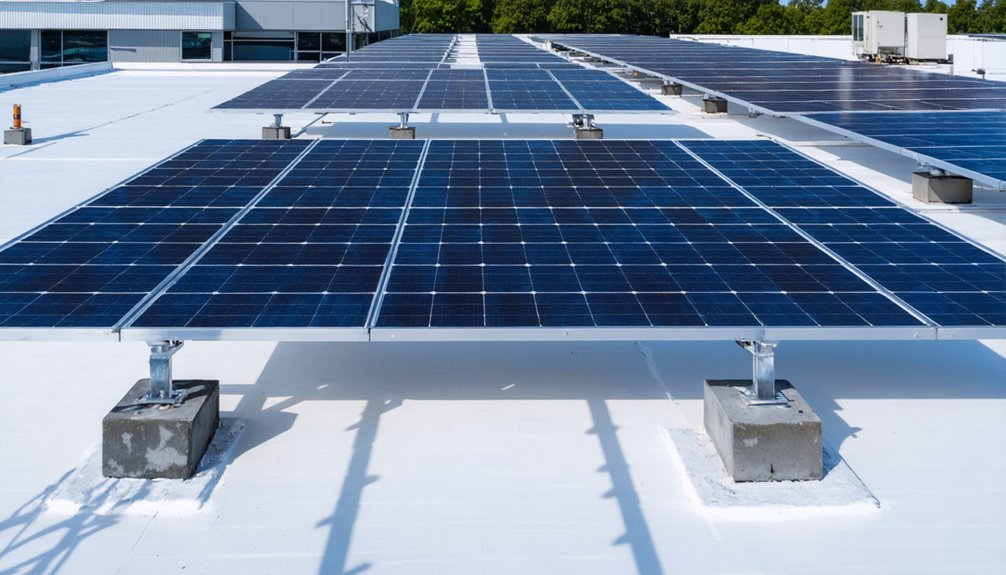You’ve probably seen solar panels on rooftops, but you might not know they don’t always need screws or bolts. Some systems sit on flat roofs using heavy concrete blocks to stay in place. These ballast mount systems work like paperweights, holding panels down without making holes in your roof. They’re becoming popular for commercial buildings and apartments. Understanding how these systems work could change what you think about solar installation options.
How Solar Panel Ballast Mount Systems Work

When you see solar panels on flat commercial rooftops, they’re often held in place by heavy concrete blocks rather than bolts or screws. These solar panel ballast mount systems work by using ballast weight to keep panels secure on the installation surface. The heavy blocks counteract wind uplift forces that try to lift panels off flat roofs.
Professional engineers calculate the exact weight needed for structural stability. They’ll consider your local weather patterns and roof strength. The systems distribute weight evenly across the surface to avoid roof penetrations that could cause leaks.
You’ll find these mounts can be adjusted to achieve the best tilt angles. This adjustment improves energy capture while maintaining safety. The ballast blocks act like anchors, using gravity to hold everything in place without drilling into your roof. Unlike pole mount systems that offer enhanced adjustability for optimal sun exposure, ballast mounts provide a simpler solution for flat roof installations while still allowing angle modifications.
Key Components of a Ballast Mounting System
Every ballast mounting system relies on several essential parts working together. You’ll find pre-fabricated frames that hold solar panels securely in place. These frames connect to ballast trays filled with ballast materials, usually concrete blocks. The concrete provides weight for stability without causing structural damage to your roof.
The system’s adjustable tilt angle lets panels capture maximum sunlight. You can set angles between 10 and 35 degrees. Engineers design ballasted solar mounting to withstand environmental forces like wind and snow through strategic weight placement.
Regular inspections help maintain the durability of concrete ballasts since weather can wear them down. The ballast system’s weather resistance makes it suitable for various climates, though different mounting options offer varying levels of protection against harsh conditions. Each component plays a vital role in solar panel installations, working together to create a secure, non-penetrating mounting solution.
Benefits of Choosing Ballasted Solar Installations
You’ll find several key advantages when you choose ballasted solar installations for your building. These systems don’t require drilling holes in your roof, which means you won’t have to worry about water leaks or voiding your roof warranty. The installation process is typically faster than traditional mounting methods, and this speed often translates into lower labor costs for your project. Unlike pole mounting systems that require extensive groundwork and concrete foundations, ballasted mounts simply rest on your existing flat roof surface with weighted blocks.
No Roof Penetrations
Most building owners appreciate solar panel ballast mount systems because they don’t require drilling holes in the roof. These ballasted solar systems use concrete blocks to secure panels without creating roof penetrations.
This flat roof mounting method helps reduce risk of leaks. When you don’t drill through the roof, you maintain the integrity of roofing warranties. Building owners also minimize liability issues related to water damage.
The solar panel mounting process becomes simpler too. Workers can complete the installation faster since they’re not making holes in the roof structure. This approach helps enhance efficiency of the entire project.
Without roof penetrations to worry about, maintenance becomes easier. You won’t face complicated repairs if leaks develop. That’s why many commercial buildings choose ballasted systems for their solar installations.
Quick Installation Process
Setting up ballasted solar systems takes less time than traditional mounting methods. You’ll find the quick installation process eliminates the need for drilling into roofs. Workers can secure panels using heavy concrete blocks instead.
The solar mounting system uses pre-fabricated frames that snap together easily. Installation time drops because crews don’t need special drilling equipment. This flat roof racking method means reduced labor costs for property owners.
Ballasted systems let installers adjust for optimized panel orientation right away. They can position panels to catch the most sunlight without complex measurements. Since there’s no roof penetration, workers complete jobs faster with fewer tools.
These systems typically need smaller installation crews. The straightforward assembly process helps contractors finish projects quickly and move to the next job sooner.
Cost Savings Potential
Beyond quick installation times, ballasted solar systems offer significant savings for building owners. You’ll spend less upfront because these systems don’t need specialized equipment or extensive site prep. The installation process requires fewer workers, cutting labor costs.
Since there aren’t any roof penetrations, you won’t worry about leaks. This protects your roof and reduces maintenance costs over time. The simplified logistics mean shorter project timelines, saving money on labor and equipment rentals.
These adjustable configurations help maximize energy output. You can reposition panels easily without permanent mounting hardware. If you need to relocate the system later, you’ll avoid costly removal and reinstallation expenses.
The combination of lower installation costs, reduced maintenance needs, and increased energy production makes ballasted systems an economical choice for many buildings.
Ideal Applications for Ballast Mount Systems

When you’re looking for a solar mounting system that doesn’t require drilling into your roof, ballast mount systems offer a practical solution. These systems work best on flat commercial rooftops where drilling isn’t wanted. You’ll find them on warehouses, office buildings, and shopping centers.
The mounting design uses heavy concrete blocks to keep solar panels in place. Engineers can make these systems wind-resistant for areas with strong storms. They’ll adjust the weight and placement of ballast blocks based on local weather conditions.
You can also use these systems for ground installations. They’re helpful when you can’t dig into the soil or concrete. The flexible design lets installers tilt panels at different angles. This helps maximize energy production throughout the year. Unlike traditional ground mount systems, ballast mounts provide installation flexibility without permanent foundation requirements.
Engineering Requirements and Professional Assessment
Installing a ballast mount system isn’t something you can do on your own. You’ll need a licensed professional engineer to perform a structural assessment before any solar ballast systems go on your roof.
The engineer checks if your roof can handle the extra weight. They’ll calculate the roof load by considering the panels and concrete blocks. Environmental conditions matter too. Wind, snow, and rain affect how much weight you’ll need for ballasted solar mounting. These systems undergo rigorous wind and snow load testing to ensure they can withstand various weather conditions without compromising roof integrity.
Weight distribution is essential. Engineers make sure there aren’t any local stress points that could damage your roof. They’ll verify everything meets building codes and follows manufacturer guidelines.
You can’t just install and forget these systems. Regular inspections help maintain performance, especially if you’re in an area with extreme weather.
Installation Process for Ballasted Solar Arrays
Contractors arrive with trucks loaded with panels, frames, and concrete blocks to begin the installation. They’ll first check your roof’s structural integrity and calculate proper weight distribution. A detailed site survey examines environmental conditions like wind speeds and drainage.
| Installation Step | Purpose |
|---|---|
| Structural Assessment | Guarantees roof can support ballasted solar racking |
| Site Survey | Evaluates wind and weather patterns |
| Frame Placement | Sets up non-penetrating support system |
| Ballast Application | Secures panels with heavy concrete blocks |
Workers position panels on frames, adjusting tilt angles based on solar panel orientation and seasonal sunlight. They’ll secure everything with concrete blocks without drilling into your roof. Professional installers often use engineered mounting solutions specifically designed for flat roofs to ensure optimal performance and stability. The installation process ends with engineers verifying all components meet local building codes and safety standards.
Maintenance and Long-Term Durability Considerations

Although ballasted solar systems don’t penetrate your roof, they still need regular care to stay in good shape. You’ll need annual inspections to check for problems caused by environmental exposure. Weather and freeze-thaw cycles can damage concrete blocks over time.
Your maintenance team will look for scaling and cracking in the ballasts. They’ll schedule repairs before winter, especially if you live where there’s lots of snow or wind. Using high-quality materials helps prevent these issues and guarantees long-term durability.
Weight distribution remains critical throughout your solar installation’s life. Professional engineering assessments confirm your roof maintains its structural integrity under the ballast load. Early detection of problems through regular inspections can save you money and extend your system’s lifespan.
Comparing Ballasted Systems to Alternative Mounting Methods
Anyone choosing a solar mounting system faces several options beyond ballasted designs. Traditional mounts anchor directly into roofs or ground surfaces. They’re drilled and secured permanently.
Ballasted systems offer more flexibility than traditional mounts. You won’t need roof penetrations or ground excavation. The weight of the ballast provides stability instead of anchors. Installation happens faster on flat surfaces.
Traditional solar mounts perform better in high winds and heavy snow. They’re stronger for extreme weather. Ballasted systems might need extra weight to match that stability.
In residential and commercial urban areas, ballasted designs save money. You’ll use existing roof space without major prep work. The environmental impact stays minimal since there’s no digging or drilling. However, traditional mounting gives better long-term durability in harsh climates. While ballasted mounts provide stable positioning, adjustable panel mounts can increase solar output by up to 25% through optimal angle positioning throughout changing seasons.
Conclusion
You’ve learned that ballast mount systems use concrete blocks to hold solar panels on flat roofs. They don’t require drilling holes, which prevents leaks. The weighted design fights against wind while letting you adjust panel angles. These systems work best on commercial buildings with strong, flat roofs. They’re easier to maintain than bolted systems and cost less to install. Many businesses choose them because they protect roofs while generating clean energy efficiently.


